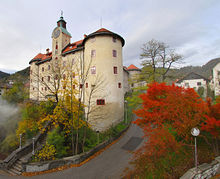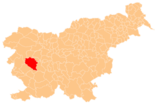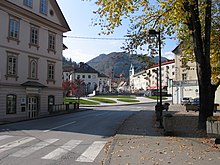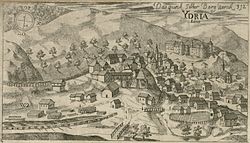Idrija
| Idrija | |||
|
|||
| Basic data | |||
|---|---|---|---|
| Country |
|
||
| Historic region | Coastal land / Primorska | ||
| Statistical region | Goriška (Gorica) | ||
| Coordinates | 46 ° 0 ' N , 14 ° 2' E | ||
| height | 326 m. i. J. | ||
| surface | 293.7 km² | ||
| Residents | 12,034 (2008) | ||
| Population density | 41 inhabitants per km² | ||
| Post Code | 5280 | ||
| License Plate | GO | ||
| Structure and administration | |||
| Mayor : | Bojan Sever | ||
| Website | |||
Idrija ( German and Italian : Idria ) is a municipality and city in the Goriška region in Slovenia . The city was named Alpine City of the Year 2011.
location

Idrija is located in western Slovenia and belongs to the Goriška region . It is located in the upper part of the Idrijca river (German: Fetschenbach ) in the transition from the subalpine zone to the karst region .
Inhabitants and districts
12,034 people live in the community, which consists of 35 localities and hamlets (as of 2008). The town of Idrija itself has 5878 inhabitants.
- Dole (German: Dollach )
- Čekovnik (German: Klausen )
- Črni Vrh (German: Schwarzenberg )
- Godovič (German: Godowitsch )
- Gore (German: Tschudenberg , also albums )
- Gorenja Kanomlja (German: Ober Katel )
- Gorenji Vrsnik (German: Ober Wresnig )
- Govejk (German: Goweik )
- Idrijska Bela (German: Magdalenenberg , also Wellach )
- Idrijske Krnice (German: Kronz )
- Idrijski Log (German: Laag )
- Idršek (German: Hiderschegg )
- Javornik (German: Sankt Johann )
- Jelični Vrh (German: Jellitschenberg )
- Kanji Dol (German: Kainthal )
- Korita (German: Korreitach )
- Ledine (dt .: wastelands )
- Ledinske Krnice (German: Carnice near Öden )
- Ledinsko Razpotje (German: Raspoth )
- Lome (German: Lorrein )
- Masore (German: Masora )
- Mrzli Log (German: Kaltenloch )
- Mrzli Vrh (German: Kaltenberg )
- Pečnik (German: Petschnig )
- Potok (German: Bach )
- Predgriže (German: Predgric )
- Spodnja Idrija (German: Under Idria )
- Spodnja Kanomlja, (German: Under Katel )
- Spodnji Vrsnik (German: Unter Wresnig )
- Srednja Kanomlja (German: Mitter Katel )
- Strmec (German: Sternitz )
- Vojsko (German: Woischach )
- Zadlog (German: Lug )
- Zavratec (German: Sauratz )
- Žirovnica (German: Scheraunitz )
Economic history
Lace making
Bobbin lace has been practiced here for over 300 years . A lace school has existed for 120 years and the well-known Čipakarski Festival takes place here at the end of August .
Mercury mine
The area became known through the mercury discovery in 1493. The mineral idrialin discovered here is named after the place where it was found . For 500 years, until it was closed, the Idrija mercury mine was the second largest in the world. In its heyday, the plant nevertheless covered 13 percent of the world market. Up to 1,300 people found work there. Part of the old mine can still be visited today. In 2012 it was added to the list of UNESCO World Heritage Sites together with the Spanish mine of Almadén .
Health consequences for the population
One of the historically best-known examples of chronic mercury poisoning is the Slovenian city of Idrija, where the world's second largest mercury mine was located until it was closed in the 1970s. A mental hospital had to be built on site at an early stage , as the health-damaging effects of mercury attacked the nervous system of many workers. The famous doctor Paracelsus already reported on the sick population in 1527: “See an example in Idria; everyone who lives there is crooked and lame. ”The situation only improved at the end of the 18th century thanks to improved processing methods.
Environmental degradation
Because mercury was economically extremely important for the Habsburgs , the mine was expanded quickly. As a result, a lot of wood was needed to support the tunnels and to fire the melting furnaces. The wood required for this was first fetched from the mountains in the immediate vicinity. The lack of wood was increased by the influx of workers ( miners ). The need for firewood and construction timber for their accommodation increased. In addition, slash and burn was carried out to create space for accommodation and arable land for the workers.
Already in 1534 there were complaints about the lack of wood and within only one generation (up to about the year 1550) the forest was destroyed. There were also complaints about “poisonous smoke”, deformities in animals and the decline in harvests. The deforestation led to erosion and karstification of the soil. The introduction of improved and thus wood-saving combustion processes was prevented until around 1650 by the miners who feared for their jobs.
city Museum
Both topics - both lace making and the mining of mercury - are illuminated in the city museum.
A large company based in Idrija is now the Kolektor Group , a plant engineering company and manufacturer of components for the construction of electric motors.
Buildings
- Handwerkenegg Castle from 1533
- Antonius tunnel, the oldest tunnel carved into a rock in the city center around 1500
- Partisan printing shop from 1944 in a water-bearing gorge in the wider area of the city
- Long sleeper railways from Idria (around 1853–1875)
Memberships
Idrija is involved in the Alpine City of the Year Association together with other Alpine cities for the implementation of the Alpine Convention and for the sustainable development of the Alps.
sons and daughters of the town
- Anton Kautschitz (1743–1814), Auxiliary Bishop of the Archdiocese of Vienna and Bishop of the Diocese of Laibach, now the Archdiocese of Ljubljana .
- Anton Alois Wolf (1782–1859), Bishop of the Diocese of Ljubljana, today the Archdiocese of Ljubljana .
- Emilie Kraus von Wolfsberg (1785–1845), from 1805 the mistress of the French Emperor Napoleon I for several years.
literature
- Heinrich Blank: On the history of the Idrian mercury trade in the 16th century , dissertation Univ. Munich 1928 (unpublished?).
- Peter Hitzinger: The Idria mercury mine, from its beginnings to the present , Laibach 1860 ( digitized version )
- Franz Kossmat : About the geological conditions of the mining area of Idria . in: Yearbook of the Imperial and Royal Geological Institute, vol. 49, Vienna 1900, pp. 259–286 ( digitized version ; PDF file; 2.26 MB)
- Helfried Valentinitsch: The princely mercury mine Idria 1575-1659 , Graz 1981.
Web links
- Website of the municipality in Slovenian
- Information in German
- Info in German about the mercury mine
Individual evidence
- ↑ http://www.bergleben.de/wandern/2094-alpenstadt-des-jahres-2011-slowenische-stadt-idrija-gewaehlt.html
- ↑ https://www.idrija.si/objave/175
- ↑ Dumont Travel Guide Slovenia 2001
- ↑ UNESCO World Heritage Center: Heritage of Mercury. Almadén and Idrija
- ^ Alois Scheucher, Anton Wald, Eduard Staudinger, Josef Scheipl, Ulrike Ebenhoch: Zeitbilder 5 & 6, History and Social Studies - Political Education. From the beginnings of human history to the end of the First World War , Österreichischer Bundesverlag Schulbuch GmbH & Co KG, Vienna, 1st edition, 2006, p. 116.
- ^ Alois Scheucher, Anton Wald, Eduard Staudinger, Josef Scheipl, Ulrike Ebenhoch: Zeitbilder 5 & 6, History and Social Studies - Political Education. From the beginnings of human history to the end of the First World War , Österreichischer Bundesverlag Schulbuch GmbH & Co KG, Vienna, 1st edition, 2006, p. 115 f.
- ↑ Peter Hitzinger: The Idria Mercury Mine, from its beginnings to the present , Laibach 1860






